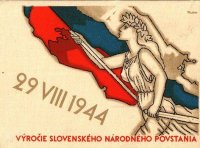 On 29 August, the people of Slovakia commemorate the Slovak National Uprising national holiday, which was established to commemorate the beginning of the uprising of the Slovak nation against the Nazis in 1944.
On 29 August, the people of Slovakia commemorate the Slovak National Uprising national holiday, which was established to commemorate the beginning of the uprising of the Slovak nation against the Nazis in 1944.The biggest celebrations are held in the town of Banská Bystrica, where the rebels had their headquarters. Currently, the Museum of the Slovak National Uprising is located there.
The uprising took place from 29 August to 28 October 1944 and affected a third of the country's territory where approximately 1.7 million people lived. German troops together with Slovak fascists reacted to the revolt with mass executions and declared martial law. This brought great suffering to the local population. Soviet troops together with soldiers of the 1st Czechoslovak Army Corps tried to lend a helping hand to the rebels and on 6th October seized the Dukla Pass. However, on 27 October the fascist troops (who were heavily outnumbered) occupied Banská Bystrica and the rebels were forced to retreat into the mountains. Although the uprising was suppressed partisan units fought in the mountains until January 1945 when they joined the advancing Soviet army.
Thanks to the Slovak National Uprising Slovakia became a member of the Allied coalition that defeated fascism. This event was one of the brightest pages in the history of the Slovak nation proving that the pro-fascist state headed by Jozef Tiso was not the main representative of the nation.
We must remember those who gave their lives in the fight for freedom.
May their memory be eternal!
Author: Dominika Lavríková Verešová


